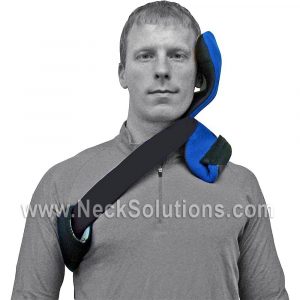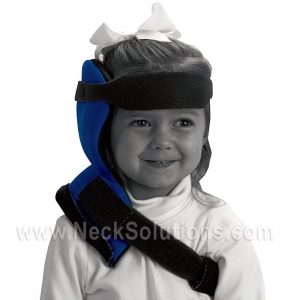Congenital Muscular Torticollis Is Caused By A Shortening Of The Muscles On One Side Of The Neck
What is congenital muscular torticollis?
Congenital muscular torticollis (CMT) is a common condition usually discovered in the first few months of life. It may be associated with a harmless lump in the muscle which should disappear in a few months. First-born children are more likely to have torticollis. Congenital means present at birth and torticollis means twisted neck. The “lump” is likely from intrauterine packing, resulting in injury to the muscle. As this clears up, the amount of scar in the muscle may determine how tight the muscle is. Some have suggested the sternomastoid muscle (SCM) shortens as a result of scarring due to an intrauterine vascular disturbance. There is no known prevention.
If you notice that your child holds the head tilted to one side for prolonged periods, consult your physician. Other conditions can cause torticollis, and the physician will check for those during the physical examination. X-rays and/or an ultrasound of the neck and/or hips may be taken. When a full evaluation rules out a structural or neurologic cause in torticollis, conservative therapy can be safely instituted.
A 2019 study in the journal Pediatrics indicates the incidence of congenital torticollis is on the rise and requires more collaboration between physicians and therapists for appropriate management. The increased incidence has been attributed to cultural factors, like the the Safe to Sleep campaign to avoid sudden infant death syndrome, decreased stomach positioning for play, and the use of infant positioning equipment.
What are the symptoms of congenital muscular torticollis?
Although infants are not expected to spontaneously resolve, fortunately, the condition does not cause pain. The head tilts to one side and the chin points to the opposite shoulder. The right side is involved 75% of the time. If there is a lump found in the muscle and it gradually goes away. There is limited range of motion of the neck. One side of the face and head may flatten as the child always sleeps on one side and the shortening of the muscle often leads to craniofacial asymmetry as a coexisting impairment in up to 90%.
A 2019 Review in Review Pediatrics indicates outcomes are best when infants are diagnosed early and start comprehensive therapy management before 3 months of age. If untreated, it can lead to craniofacial deformities, cervical spine dysmorphism (abnormal difference in structure), and painful, limited cervical motion that may require more invasive interventions like injections and surgery.
What is the treatment for congenital muscular torticollis?
Conservative treatment consists of positioning and stretching exercises to turn the head so that the chin touches each shoulder and also so that the ear touches the shoulder.
A 2017 study in the Journal of Back & Musculoskeletal Rehabilitation found that soft tissue mobilization techniques that are used in clinical practice, when administered three times a week for six weeks, results in faster results when added to conservative management. These techniques are similar to massage, often using deeper techniques in combination with motion of the affected area.
There are other options that can help. A collar called the Tot Collar may be fitted and used to aid in correction. Position toys where the infant has to turn his head to see them. Carry the child so that they have to look to the involved side. Place the child in bed with the involved side toward the wall so that they have to look the opposite way to see you outside the crib. There is also a Torticollis Brace that provides progressive resistance to help correct the condition.
In about 10% of children, surgery may be needed to correct the torticollis. This is an outpatient surgery to lengthen the short muscle.
What are the results of treatment?
Following a consistent home program overseen by a therapist, your child’s condition may improve in a few months, however, each child is different.
What can I do at home?
The following are some suggestions. They are positioning or postural and are shown for right congenital muscular torticollis, so if your child has left torticollis, do them on the opposite side. The side of torticollis is named after the side the child’s head is tilted (ear towards shoulder and chin to opposite side or face pointed to opposite side).
 |
 |
Carry your child over your left shoulder so he or she turns his or her head to the right.
If less than 4 months old, cradle your child on his or her right side with his or her head resting on your right elbow.
Hold your child facing you against your chest with his or her head turned toward the right. Hold this position as long as he or she will let you.
In all positions (back, tummy, upright) practicing having your child looking towards their right side. Encourage your child to look as far possible over his or her right shoulder. You can stabilize the right shoulder.

Tummy Carry: Carry your baby so that your baby is facing away from you or is on their stomach. Try to get your baby to look up while in this position. This will help make the neck and back muscles stronger. Encourage your baby to reach forward with their arms.
Tummy Time: Put your baby on their stomach. If needed, use a small blanket or towel roll to help prop your child on their elbows. You can work on a ball, your lap, a boppy or your chest. You can also carry your baby horizontally with your arms supporting their chest.

Lean or tip your child to his right side. Allow your child to correct head position towards upright. Various positions can be used for this activity (carrying, sitting, in your lap, on hands and knees, side sitting, or lying on his or her right side).
This is not a comprehensive list of activities, just some of the basics. Stretching should also be done and your therapist can give you stretching exercises and help you monitor the progress, as well as the addition of soft tissue mobilization and/or massage techniques.
A 2023 study in Frontiers in Pediatrics found massage therapy in infants with congenital muscular torticollis was a safe and effective method to improve cervical function and range of motion.
Prior to stretching the SCM muscle, massage therapy using finger rubbing and stroking method reduced muscle tension and increased flexibility. To achieve a consistent level of intensity, the massage therapy was performed by the same senior physician. Massage was performed for 3 minutes and then gently stroked with the thumb from the starting point to the ending point of the muscle for 2 to 3 minutes, careful not to press the larynx and the neck vascular bundle.
What if congenital muscular torticollis is not treated?
The muscle will remain short, making it difficult for your child to turn his or her head. The head will remain tilted to the side. This may result in flattening of the skull and facial bones.
It is important to have your baby evaluated by a health care professional and working with a therapist can bring very good results.
The importance of professional evaluation cannot be underestimated. As a 2020 study reminds us that torticollis is a sign that is not always innocent and may indicate an underlying severe disease. Some causes found in the study were cranial pathologies, spinal pathologies, ocular pathologies, and otorhinolaryngological infections. Detailed clinical physical examination and necessary laboratory investigation may be necessary.
A 2022 study in International Orthopaedics indicates a relationship between congenital torticollis and developmental hip dysplasia. The authors concluded that identification of torticollis may be beneficial to early discovery and treatment of developing hip dysplasia and should remain vigilant to perform physical exam and screen imaging.
A 2022 study in Pediatric Physical Therapy found gastroesophageal reflux disease (GERD) was prevalent in over 30% of infants with congenital muscular torticollis in a prospective cohort study of 155 infants.
A 2023 study in BMC Musculoskeletal Disorders used ultrasound to distinguish 3 characteristics of the sternocleidomastoid muscle: local mass, uniform thickening, and atrophy. The authors indicate this typing can assist in decision making regarding treatment and “Early diagnosis and treatment are essential to improve the conservative treatment success rate and achieve good prognosis in children with CMT”.




